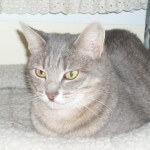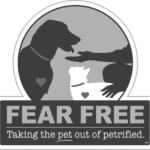Duck, Duck, Green Pea?
June 12, 2012
 Phoebe was brought into my clinic by a good client who frequently rescued stray cats in her neighborhood. Since she already had many cats at home, my client couldn’t keep Phoebe but wanted us to assess her health before finding her a home. When I first looked at Phoebe, she was missing most of the fur on the back half of her body. She had large, ulcerated wounds on the backs of both thighs, ulcerated areas on her stomach, and tiny scabs over most of her back. If that wasn’t bad enough, she also had two very large ulcers on her upper lips. Somehow, despite her skin misery, she purred throughout the appointment.
Phoebe was brought into my clinic by a good client who frequently rescued stray cats in her neighborhood. Since she already had many cats at home, my client couldn’t keep Phoebe but wanted us to assess her health before finding her a home. When I first looked at Phoebe, she was missing most of the fur on the back half of her body. She had large, ulcerated wounds on the backs of both thighs, ulcerated areas on her stomach, and tiny scabs over most of her back. If that wasn’t bad enough, she also had two very large ulcers on her upper lips. Somehow, despite her skin misery, she purred throughout the appointment.
The appearance of Phoebe’s skin, particularly the ulcers on her lips, was characteristic for allergic skin disease, with a severe secondary skin infection. Cats with skin allergies commonly develop “rodent ulcers” on the lips, also known as eosinophilic granuloma complex (ECG) lesions. These can be very painful, and sometimes prevent the affected kitty from eating; ECG lesions can also occur within the mouth, on the tongue and on the palate. Ouch! The burning question for Phoebe…to what was she allergic?
So many potential allergens exist that can trigger the symptoms displayed by Phoebe. Flea allergies are the most common cause of rodent ulcers in cats, so I immediately applied Advantage to Phoebe for prompt flea control. Even though Phoebe exhibited no obvious symptoms of a flea infestation, I knew that was a variable we could control. As I tell my clients frequently, cats are such meticulous groomers, they often groom away all the obvious evidence of a flea problem. You may never see a flea on your cat, but it doesn’t mean the fleas aren’t there! Plus, fleas are a lot easier to treat and prevent than some of the other potential allergies we see. I usually recommend monthly flea treatment for all itchy cats and dogs, without exception.
Next on the list of potential allergies is a condition called atopy, or atopic dermatitis. This frequently occurs in humans, dogs and cats and essentially it is skin disease resulting from environmental allergens. Hundreds of potential allergens exist, ranging from things in the home such as dust mites and molds, to outside allergens such as pollens and grasses. I’ve even had patients undergo allergy testing and test positive for allergies to humans! These allergens are obviously difficult to diagnose, and control. Without allergy testing, we are really just guessing as to what the potential allergens could be and we are very often incorrect.
Setting atopic dermatitis aside as a potential diagnosis, I also considered the likelihood that Phoebe had a food allergy. Since Phoebe was a stray, we were unsure of her previous diet. Beef, chicken, wheat and corn are reported as the most commonly allergenic ingredients for dogs and cats, and the vast majority of pet foods and treats contain one or more of these ingredients. About 20% of cats and dogs with symptoms of allergic skin disease have a food allergy; food allergic pets may also display gastrointestinal symptoms such as vomiting, diarrhea and/or chronic weight loss. Food allergies in pets can affect the skin, the GI tract or both! Given the severity of Phoebe’s skin disease, I knew it was reasonable to consider a hypoallergenic diet for her moving forward.
While we were working toward Phoebe’s underlying diagnosis, I treated her with antibiotics to manage her skin infection. She was also given a short course of steroids to manage her body’s overactive immune response (basically, that’s an allergy in a nutshell), as well as control any itching and inflammation. Phoebe boarded at my hospital for two weeks while we treated her skin disease, and she began to heal beautifully. Our whole staff fell in love with her sweet disposition, myself included. Since I had recently lost my own two cats due to illness, my husband and I decided to adopt Phoebe, allergic skin and all.
Phoebe has been living with us for close to three years, and her skin has never again looked the way it appeared on the first day I met her. Fortunately, I did not need to pursue skin allergy testing for her, since Phoebe and her skin have been asymptomatic on a hypoallergenic diet since she came into our home. There are a variety of hypoallergenic pet foods out there, but the goal is to feed the animal a novel protein (such as venison, duck, or rabbit) and a novel carbohydrate (such as sweet potato, oat or green pea). Cats are notoriously picky eaters, but often seem to like a duck and green pea diet. Prescription hypoallergenic diets are vastly preferred to those sold in pet stores, since vigorous scientific testing and quality control measures are in place for the prescription diets; unfortunately, foods sold in the grocery store and pet stores have not been studied and often are made in facilities that have cross-contamination from allergenic ingredients. Phoebe has eaten Hill’s D/D Feline Skin Support Duck & Green Pea diet for years, and it has helped completely control her skin disease. Quack!



